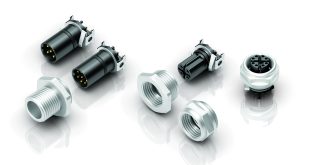Rob Crookes, product manager at CP Electronics explores the best connector configuration for modular lighting control applications…
 One of the most exciting developments in the construction industry in recent times has been the modular building boom. With unprecedented demand for greener, faster and smarter building methods, the evolution of modular technology continues to shape the expectations of the construction industry and, therefore, the design of modular lighting control systems. At the heart of every modular lighting control system is its connectivity. Traditionally, the integration of luminaires and lighting system components was made possible with a 6-pole GST connection system. In such instances, a black and grey connector configuration ensured a safe connection of the Live, Earth, Neutral, Maintained Live and Dimming Pair, faciliating a connection from an LCM to a luminaire or daisy chain system via extender cables and tee modules. Following concerns raised by the lighting industry, we are likely to see a transition to a black and blue coding system. While eventually this may be backed by legislation, it is already considered best practice to adopt this approach to coding.
One of the most exciting developments in the construction industry in recent times has been the modular building boom. With unprecedented demand for greener, faster and smarter building methods, the evolution of modular technology continues to shape the expectations of the construction industry and, therefore, the design of modular lighting control systems. At the heart of every modular lighting control system is its connectivity. Traditionally, the integration of luminaires and lighting system components was made possible with a 6-pole GST connection system. In such instances, a black and grey connector configuration ensured a safe connection of the Live, Earth, Neutral, Maintained Live and Dimming Pair, faciliating a connection from an LCM to a luminaire or daisy chain system via extender cables and tee modules. Following concerns raised by the lighting industry, we are likely to see a transition to a black and blue coding system. While eventually this may be backed by legislation, it is already considered best practice to adopt this approach to coding.
Why the change?
To understand the rationale behind the change, we need to look at the existing 6-pole configuration, specifically, the grey connector itself, which acts as a mains connector. It has a leading earth pin, with Live, Earth and Neutral clearly marked up as a means of denoting the relevant poles. The dimming pair are connected to the earth and neutral terminals, in what has now become standard practice within the industry. This means that the two terminals are now being used for two cables which have a specific function other than that indicated by the poles of the connector. With the blue connector, by contrast, there is no leading earth pin, and the poles are marked one, two and three, to give a visual representation of the dimming pair. The impact of this is that the dimming pair can be connected to pins two and three and with the Live connected to pin one.
Compatibility
 The key thing to remember is that blue and grey connectors are not compatible due to the fact they have a different mechanical keyway, ensuring that mains and control remain separated throughout the system. In the modular building industry, with its emphasis on speed and efficiency, it is absolutely vital to ensure that the correct colour coding is selected for the product range being installed on a project. Failure to do so can result in a number of potential issues including installer safety, damage to equipment and delays to the project due to the ordering of incorrect equipment – somewhat negating the benefits of a modular system in the first place. Crucially, this must remain consistent throughout the project, without mixing the grey and blue colour coding at any point. As we continue the transition towards the new coding, it is essential to have a clear understanding of your requirements for leads and connectors to eliminate any potential problems with your project.
The key thing to remember is that blue and grey connectors are not compatible due to the fact they have a different mechanical keyway, ensuring that mains and control remain separated throughout the system. In the modular building industry, with its emphasis on speed and efficiency, it is absolutely vital to ensure that the correct colour coding is selected for the product range being installed on a project. Failure to do so can result in a number of potential issues including installer safety, damage to equipment and delays to the project due to the ordering of incorrect equipment – somewhat negating the benefits of a modular system in the first place. Crucially, this must remain consistent throughout the project, without mixing the grey and blue colour coding at any point. As we continue the transition towards the new coding, it is essential to have a clear understanding of your requirements for leads and connectors to eliminate any potential problems with your project.
For further information about CP’s range of leads and connectors, please visit: https://www.cpelectronics.co.uk/energy-saving-products/modular-wiring-solutions or call +44(0)333 900 0671.
 CIE Components in Electronics
CIE Components in Electronics



